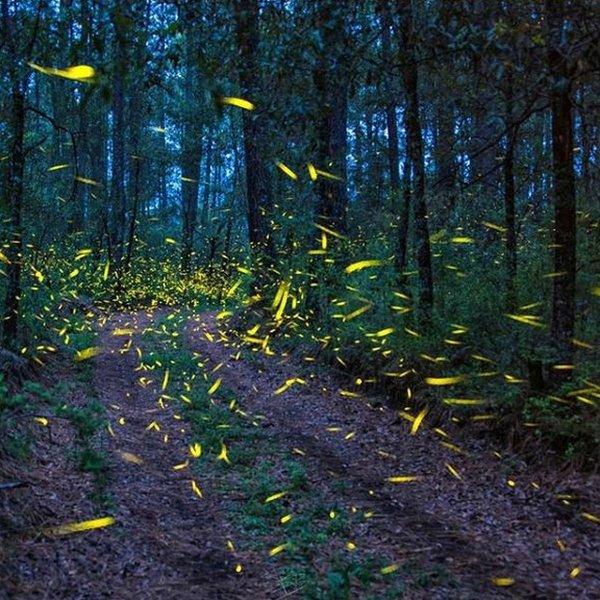Fireflies face extinction risk - and tourists are partly to blame
- Published
- comments

Firefly tourism is growing in countries including Mexico, Japan, Malaysia and India
Firefly tourism is on the rise globally but scientists are warning it may contribute to risk of the insect's extinction.
"I spotted a hundred flickering lights, illuminating a palm like a Christmas tree."
"Our guide waved his flashlight at the fireflies. They slowly engulfed us - we were surrounded by a shiny galaxy of glowing beetle stomachs."
"I reached out a hand and captured one in my fist."
Reading this travel blogger's enchanting experience in 2019 makes it clear why firefly tours are popular, but done badly, it risks killing the insects.
Habitat loss and light pollution from urbanisation and industrialisation are the leading threats to firefly populations, according to research published this week., external
But firefly tourism, which attracts thousands of visitors in countries including Mexico, the US, the Philippines and Thailand, is a growing concern for conservationists.
"Getting out into the night and enjoying fireflies in their natural habitat is an awe-inspiring experience," Prof Sara Lewis at Tufts University, who led the research, told the BBC.
But tourists often inadvertently kill fireflies by stepping on them, or disturb their habitat by shining lights and causing soil erosion.
Firefly festivals are organised in countries including Japan, Belgium, and India, and social media is magnifying this tourism, she adds.
How tourism can kill fireflies
The tiny town of Nanacamilpa in Mexico became a celebrated firefly spot in the past decade.
Some visitors post their sparkling photos on Instagram, flouting the ban on photography that many site managers impose, says local photographer Pedro Berruecos.
The Mexican fireflies are especially vulnerable to tourists, Prof Lewis explains.

Estimated annual visitors to firefly sites
Malaysia: 80,000
Great Smoky Mountains, Tennessee: 30,000 in two-three week summer season
Taiwan: 90,000
Mexico: 200,000 in 2019, up from 180,000 in 2018
Source: Professor Sara Lewis, Tufts University

The female insects are wingless and cannot fly, meaning they live on the ground, where visitors walking around will trample on them.
"No blame on the tourists, but if they walk on the forest floor, they will be standing on the female fireflies who will be carrying eggs. They are killing the next generation," Prof Lewis says.
In Thailand, Malaysia and the Philippines, the industry has existed for a few decades, but is usually poorly-managed, she explains.

Firefly season is just three months in Mexico meaning the concentrated visits put extra pressure on the eco-system

Congregating Mangrove fireflies live exclusively in mangrove trees along rivers.
Males gather in huge numbers to attract females, producing the appealing glowing swarms that tourists desire.
Motorised boats are driven up the rivers, creating water swells that erode the banks, killing the trees where the fireflies live.
You might also like:
"Operators also crash boats into the banks to disturb trees and make fireflies fly out, creating a swarm for tourists to see," Prof Lewis explains.
"There is evidence that even just camera flashes disturb fireflies and interfere with their reproductive success, in addition to the flashlights used by tourists".
Is firefly eco-tourism even possible?
Prof Lewis is keen to emphasise that firefly tourism is often crucial to local economies and should not be banned.
Instead tour operators and tourists can develop eco-friendly practices.

Travel bloggers rave about their firefly experiences - Katie Diederichs chose an eco-friendly tour operator

Travel blogger Katie Diederichs and her husband, both from the US, chose an eco-friendly tour operator in Bohol, Philippines for their firefly experience in 2015.
Travelling in a small group at night in kayaks with just one light, the experience was designed to be as unobtrusive as possible, Katie explains.
"The amount of light from the fireflies made the mangroves look like Christmas trees - it was really magical.
Chief Raoni Metuktire's fight to save the Amazon rainforest
"The male fireflies were flying around, giving the illusion of twinkling, while the females blink."
The company is run by locals who love the fireflies and want to protect their environment, she explains.
But Katie says they witnessed other operators with "large motorboat of tourists" passing by them "sending waves in our direction."

Wildlife conservation photographer Carla Rhodes snaps the Big Dipper Firefly in the Catskill Mountains in New York, US
In Taiwan, the tourist board has invested in sustainable firefly tours and created "thoughtful and effective" firefly eco-tourism, Prof Lewis explains.
Sites have regulated guided tours with raised walkways that allow small groups of people to walk through the habitat without trampling on fireflies.
Instead of flashlights or headlamps that would disturb the insects, white paint illuminates the routes.
A group of scientists will meet in 2020 to set down guidelines for how to run a sustainable firefly tourism company, Prof Lewis says.
A photographer's tips for snapping responsibly
"It is very important to not disturb the fireflies' habitat while photographing," advises wildlife conservation photographer Carla Rhodes., external
She regularly photographs the Big Dipper firefly, as well as other wildlife, where she lives in the Catskill mountains in New York.
Watch where you walk, she says, and be careful with your light sources.
"And for goodness sake, please don't ever capture them!"
- Published14 November 2019
